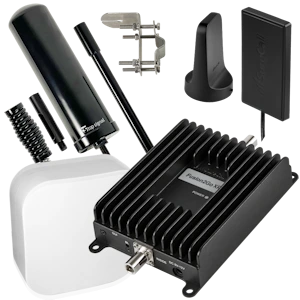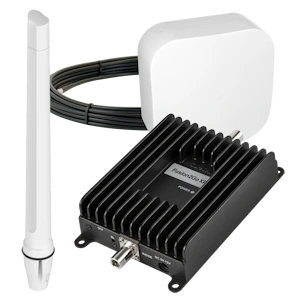Starlink vs. cellular: Which is best for home and mobile internet service?
Posted by Mike Parker on Feb 21st 2025
Starlink and cellular internet (provided by T-Mobile, Verizon, AT&T, and other carriers) are two leading options for internet access, especially for:
- Homes and businesses without wired internet service (fiber, cable, DSL)
- RVs, trailers, and Class B vans
- Boats and ships
Starlink and cellular each has its own set of advantages and disadvantages, making them suitable for different scenarios. In this blog post, we’ll compare the two and help you decide which option will work best for you.
We’ll first review coverage and availability, price, data speeds, and latency. We’ll then look at two specific use cases: RVs and marine vessels.
SureCall Fusion2Go XR Cell Signal Booster for RVs
- Strongest transmit power of any mobile booster
- Works with all North American carrier networks
- Choice of outside antenna: standard + 3 higher-gain options
- Inside directional panel antenna stands upright on any flat surface
- Dual antenna set for car or truck use
Starts at $599.99

Coverage & availability
Starlink
Starlink’s low–earth-orbiting (LEO) satellite network works almost anywhere with a clear view of the sky, offering extensive coverage in rural and remote areas where wired internet is unavailable.
Cellular
Cellular networks have widespread and increasing coverage, with over $10 billion being spent each year on increased capacity and coverage.1 Availability depends on the carrier: T-Mobile may have stronger or faster coverage than Verizon or AT&T in a given area, while Verizon or AT&T may be better in another area.
Cellular is generally most accessible in urban and suburban areas, while rural and remote regions may have weak signal or none at all. Online tools like CellMapper can help you determine carrier coverage areas in North America.
Advantage: Starlink
Starlink can usually provide internet access in any location, while cellular service depends on having a nearby cell tower. If you’re in a weak signal area, a cell phone signal booster can improve your cellular connection.
Price
Starlink
Starlink Residential for home use is $120/month for unlimited data, plus $349 to purchase the equipment (dish, WiFi router, power supply, and cables).
Starlink Roam can be used in RVs, vans, trailers, and inland or coastal marine vessels, either from a fixed location or while underway. This plan costs $50s/month for 50 GB of data or $165/month for unlimited data; the equipment costs $349 for the standard kit, $599 for the Mini kit (which you can use underway), or $2,500 for the Flat High Performance kit (recommended for boats).2
Starlink’s priority business plans—fixed, mobility, and maritime—run $140 to $5,000/month plus equipment, depending on the use case and the amount of monthly data you need.3
Cellular
Cellular costs vary, depending on the carrier. A typical wireless plan for home or mobile users with unlimited data runs $50 to $100/month per line.4 If you already have a cellular phone plan, your carrier may give you a bundled price discount to add a line for a router or hotspot. Data speeds may be throttled above a certain amount of monthly usage, depending on your plan.
A cellular router or hotspot that converts cellular data to WiFi may be provided by your carrier for little or no cost. A mobile routers or a router with advanced features can be purchased separately, with prices for reliable, name-brand equipment generally starting around $200.
Advantage: Cellular
Since most people already have an existing cellular plan, adding a router or hotspot to that plan is considerably more affordable than paying for Starlink’s equipment and monthly data.
Even if you do need a cell phone booster to improve your cellular reception, that one-time purchase will probably cost you less than one year on Starlink’s home data plan.
Data speeds
Data speeds are measured in megabits per second (Mbps).
Starlink
Starlink’s data speeds vary depending on your service plan, location, weather, and time of day. According to Starlink,5 expected downlink (DL) and uplink (UL) speeds per service plan are:
- Standard (fixed): DL 25–100 Mbps / UL 5–10 Mbps
- Mobile: DL 5–50 Mbps / UL 2–10 Mbps
- Priority (fixed & mobile): DL 40–220 Mbps / UL 8–25 Mbps
Cellular
Cellular data speeds vary depending on your carrier, location, weather, time of day, and cellular device. According to SpeedTest.net,6 in Q4 2023, median US cellular data speeds were:
- T-Mobile: DL 189.0 Mbps / UL 12.2Mbps
- Verizon: DL 91.2 Mbps / UL 10.0 Mbps
- AT&T: DL 90.8 Mbps / UL 8.1 Mbps
Median downlink speeds measured just for 5G connections were even faster:
- T-Mobile: DL 238.9 Mbps
- Verizon: DL 196.4 Mbps
- AT&T: DL 125.7 Mbps
Advantage: It depends
Location is a key factor for cellular data speeds, as short-range, high-band cellular frequencies in urban and suburban areas will provide faster speeds than long-range, low-band frequencies in rural and remote areas.
In rural and remote areas, Starlink may provide faster data than cellular can deliver. A cell signal booster can also improve data speeds in rural areas where cellular signal is weak.
Latency
In telecommunications, latency is the two-way round-trip delay in communication over a network, measured in milliseconds (ms). Latency is caused by physical distance between devices, network congestion, the protocol used for data transmission, and other factors. Low network latency is important for applications that require real-time performance, such as voice calls, video conferencing, and online gaming.7
Starlink
According to Starlink,5 expected latency per service plan is:
- Fixed (standard & priority): 25–60 ms
- Mobile: (standard & priority): < 99 ms
Cellular
According to SpeedTest.net,6 in Q4 2023, median US 4G/5G cellular latency was:
- T-Mobile: 50 ms
- Verizon: 57 ms
- AT&T: 64 ms
Advantage: It depends
As with speed, cellular frequency and distance to the tower are key considerations for latency. Cellular generally has lower latency, especially in areas close to 5G towers, making it more suitable for online gaming and video conferencing.
Starlink offers lower latency compared to traditional satellite internet due to its low–earth-orbiting satellite network, but it’s still higher than urban/suburban 5G cellular.
Use case: RV, van & trailer
Starlink
Starlink Roam can be used in vehicles that are parked or underway using the Starlink Mini dish with integrated WiFi ($599).8 As mentioned above, Starlink’s mobile data plan costs $50/month for 50 GB of data or $165/month for unlimited data,2 and mobile downlink data speeds are up to 50 Mbps.5
Cellular
Cellular data can also be used in RVs, vans, and trailers that are parked and underway. This doesn’t require any equipment besides your cell phone, although you can purchase a cellular router or hotspot that will convert your carrier’s data to WiFi; these devices start at around $200 and can cost over $1,000 for high-end equipment. As mentioned earlier, a wireless plan for a dedicated router/hotspot costs $50 to $100/month for unlimited data,4 and cellular downlink data speeds average 90 Mbps or greater6 (although they may be slower in remote areas).
Advantage: Cellular
For travelers in all but the most remote areas, cellular is the faster, more affordable choice. A cell signal booster for RVs, vans, and trailers can improve cellular reception in areas where outside signal is weak.
Starlink is the better option only if you mostly or exclusively travel in very remote areas where there is no available cellular service.
SureCall Fusion2Go XR Marine Cell Signal Booster
- Strongest transmit power of any mobile booster
- Works with all US carrier networks
- Your choice of outside high-gain marine antenna
- Inside directional panel antenna stands upright on any flat surface
- Dual-use kit also includes car/truck antennas
Starts at $849.99

Use case: marine & maritime
Starlink
Starlink Roam can be used aboard vessels that are moored or underway. As mentioned above, Starlink’s mobile data plan costs $50/month for 50 GB of data or $165/month for unlimited data,2 and mobile downlink data speeds are up to 50 Mbps.5
Starlink Roam provides coverage up to 12 nautical miles off the coast for up to 5 consecutive days at a time and a total of 60 days over the course of a one year period.9
For use on boats, Starlink recommends their $2,500 Flat High Performance kit because its wider field of view allows it “to stay connected to passing satellites when the vessel rolls or rocks on the water.”10
Cellular
Cellular data can also be used in boats and ships that are moored or underway. Cell reception is typically available 3 to 8 miles off the coast, with reception sometimes being available as far as 18 miles from shore. A marine cell phone signal booster with the right antenna will improve reception and cellular data speeds.
As mentioned earlier, a wireless plan for a dedicated router/hotspot costs $50 to $100/month for unlimited data,4 and cellular downlink data speeds average at 90 Mbps or greater6 (although they may be slower at greater distances from shore).
Advantage: Cellular
Starlink’s coverage distance from shore is comparable to cellular’s, but cellular has much lower equipment costs and doesn’t have Starlink’s limited service periods.
Starlink is the better option only if you sail in areas where there is no available cellular service.
Conclusion
Satellite internet has been around for decades, but Starlink has changed the game by offering faster data speeds, lower latency (thanks to their low–earth-orbiting constellation of satellites), and portability. It’s a fast, reliable internet option for homeowners, RVers, boaters, and campers in areas where there’s no wired or cellular service available.
Starlink’s equipment and data plans are, however, more expensive and limiting than cellular service. With 5G cellular networks continually expanding, and with the option to amplify weak cellular signal with a cell phone booster, cellular is and will remain a viable option for most people.
Recap
Notes
1 “Wireless Infrastructure By the Numbers: 2022 Key Statistics,” Wireless Infrastructure Association, 15 March 2023.
2 “Service Plans: Personal,” Starlink, accessed .
3 “Service Plans: Business,” Starlink, accessed .
4 “Unlimited Plans Comparison: T-Mobile vs. AT&T vs. Verizon,” Clark.com, updated ; Lisa Iscrupe and Hannah Whatley, “Fixed wireless internet providers 2025
,” USA TODAY, updated . The cellular prices quoted above are for plans from the three major carriers (Verizon, AT&T, T-Mobile); MVNOs offer unlimited data plans for as low as $25/month.
5 “Starlink Specifications,” Starlink, accessed .
6 “United States Median Country Speeds,” SpeedTest.net, accessed .
7 “Latency is the Next Frontier of Consumer Experience. Are You Ready?,” Ookla, .
8 “Starlink Mini: Specifications,” Starlink, accessed .
9 “What is the “Roam” service plan?,” Starlink, accessed .
10 “What is the difference between the Flat High Performance & Standard Kit?,” Starlink, accessed .

